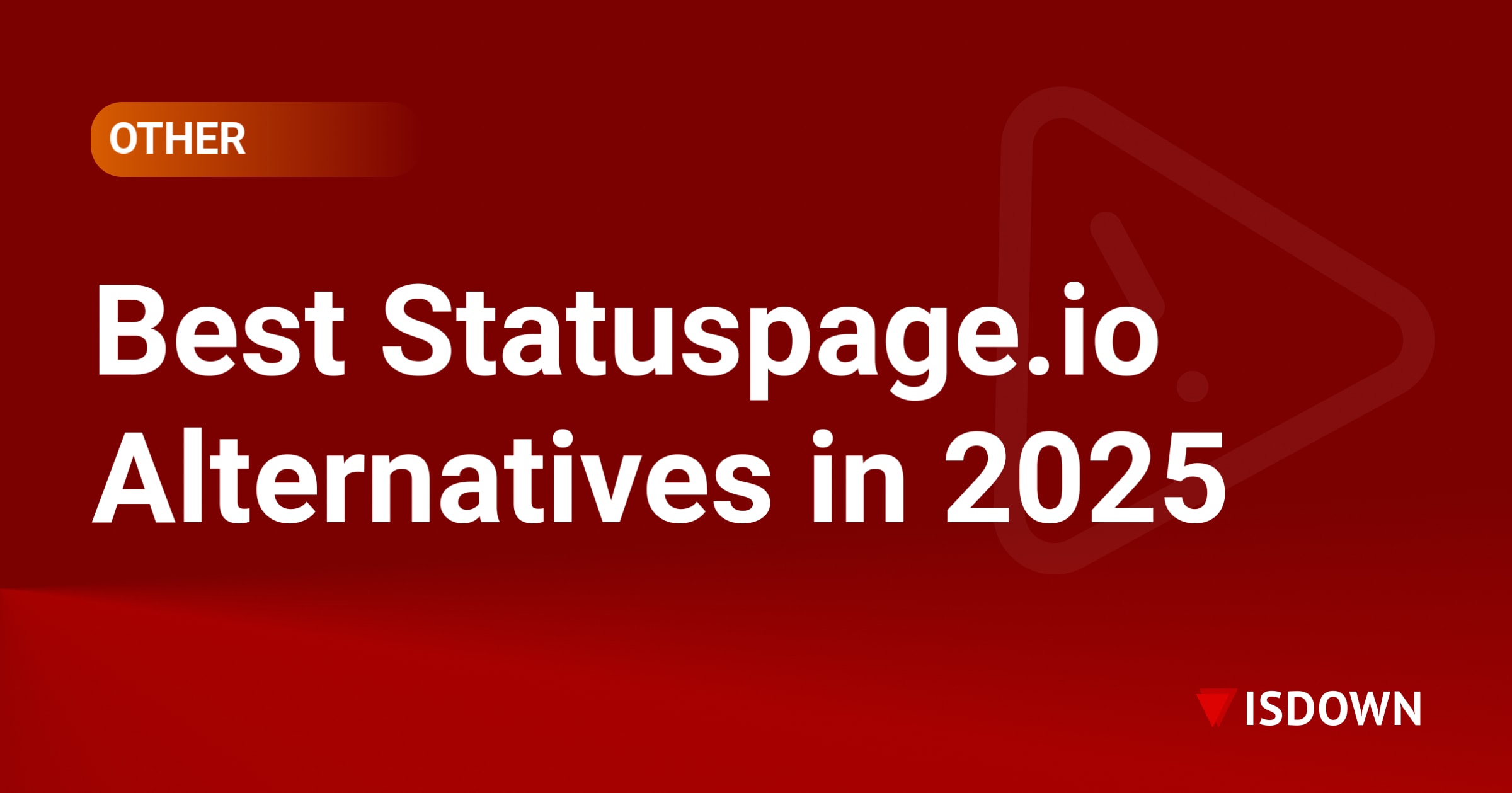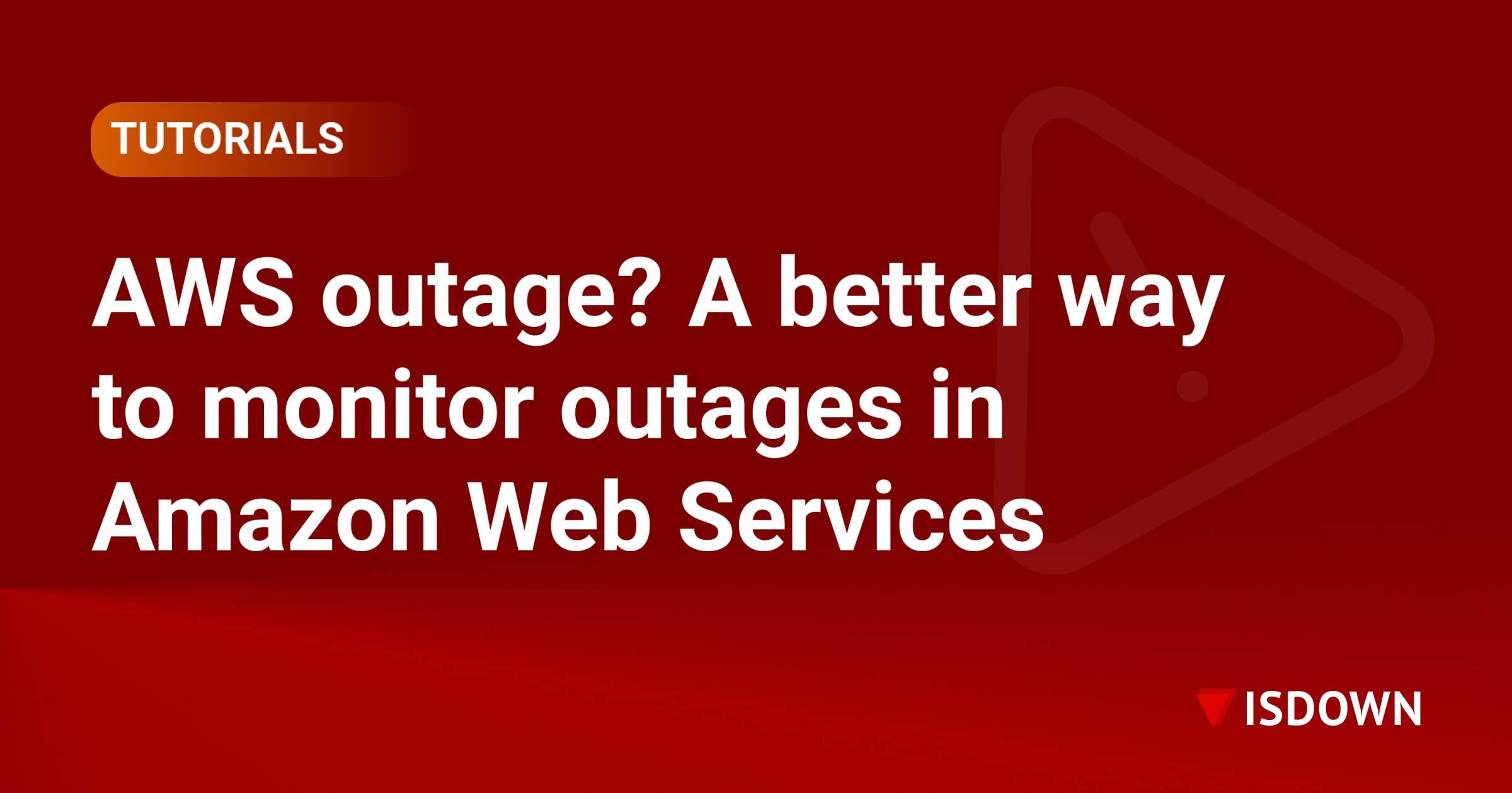Top 10 Statuspage.io Alternatives in 2025

Choosing the right status page solution can make the difference between customer trust and customer churn during incidents. This guide compares the top status page alternatives to help you find the perfect fit for your team's needs—whether you need public incident communication, internal vendor monitoring, or enterprise-grade features.
Why Status Pages Matter
Every minute of downtime costs your business money, but what really damages your brand is poor communication during incidents. A status page is no longer optional—it's essential infrastructure for any organization running online services.
Transparency Builds Trust
When things break (and they will), customers want answers. A status page shows you're in control and actively managing the situation. Leaving customers in the dark creates anxiety and erodes trust far more than the incident itself.
Reduce Support Burden by 60%
Without a status page, every affected customer opens a ticket asking "Is it down?" A single incident can generate hundreds of duplicate support requests. Your team spends hours answering the same question instead of actually fixing the problem.
Support teams report 3-5x ticket volume during incidents when no status page exists.
Proactive Communication Prevents Frustration
Customers discover issues eventually. The question is whether they hear it from you first or stumble upon it themselves. Announcing scheduled maintenance and providing real-time incident updates prevents surprise and maintains satisfaction even during outages.
Show Operational Maturity to Enterprise Buyers
Enterprise customers check your status page during evaluation. 78% of enterprise buyers consider status page availability and historical uptime data when making purchasing decisions. A well-maintained incident history demonstrates accountability and operational maturity.
The Hidden Costs of Operating Without a Status Page
The cost of a status page ranges from free to $100/month. The cost of NOT having one can be substantially higher:
Overwhelmed Support Teams
Every affected customer contacts support individually during incidents. Your team fields hundreds of duplicate tickets instead of focusing on resolution. This creates a negative support experience for customers who wait hours for basic status updates.
Customer Churn from Poor Communication
32% of customers say they'd switch providers after a single bad experience with poor communication during downtime. Customers left without information assume the worst—they don't know if it's a minor glitch or a catastrophic data breach.
Negative Social Media Amplification
When customers can't find official information, they complain publicly on Twitter, Reddit, and LinkedIn. These posts reach 10x more people than your support tickets. A status page gives customers an official channel and reduces social media fallout.
Lost Enterprise Deals
Prospective customers notice the absence of a status page. For enterprise buyers, it signals operational immaturity. Many companies require status page access before signing contracts—you're losing deals before conversations even start.
Engineering Time Wasted on Communication
Engineers spend 20-40% of incident time answering questions when no status page exists. They get pulled into support channels to explain status instead of fixing the actual problem. A status page serves as a single source of truth.
Essential Features to Look For
Not all status pages are created equal. Here's what separates excellent solutions from basic ones:
Independent Infrastructure
Your status page must stay up when everything else goes down. It should run on separate infrastructure or use a dedicated provider. A status page that fails during incidents is worse than useless.
Real-Time Updates
Stale information is worse than no information. Your status page needs current updates as soon as incidents are detected, with regular updates throughout resolution.
Component-Level Visibility
Break down your service into specific components (API, Dashboard, Mobile App, Payment Processing). Customers need to know exactly what's affected. A partial API outage requires different communication than total downtime.
Multi-Channel Notifications
Customers shouldn't need to manually check your page. Subscribers should receive updates via email, SMS, Slack, webhooks, or RSS. Automated notifications ensure critical stakeholders stay informed.
Historical Incident Transparency
Maintain an accessible incident history showing past outages and resolutions. Don't hide past incidents—transparency demonstrates accountability. Enterprise buyers specifically look for this.
Custom Branding and Domain
Your status page represents your brand during critical moments. It should match your company's look and feel, use your domain, and maintain professional consistency.
The current most popular solution in the market
Statuspage.io by Atlassian

The industry standard and most widely used status page solution. Statuspage.io offers highly customizable templates, real-time incident updates, and seamless integration with the Atlassian ecosystem (Jira, Opsgenie, Confluence).
Key Features:
Enterprise-grade reliability and infrastructure
Advanced customization with templates
Comprehensive API and integrations
Subscriber management with segmentation
Private status pages with authentication
Pricing: Starts at $29/month (free tier available)
Best For: Large enterprises with complex needs and existing Atlassian tools. Organizations requiring extensive customization and subscriber management.
Considerations: Premium features require higher-tier plans. Can become expensive for organizations with many subscribers.
The Best Attlassian Statuspage Alternatives
1. IsDown

A specialized status page aggregator designed for internal team communication and vendor dependency monitoring. Unlike public status page creators, IsDown monitors 4,500+ third-party vendor status pages (AWS, Azure, GitHub, Stripe, etc.) and lets you create private status pages with SSO protection.
Key Features:
Monitor 4,500+ vendor status pages in real-time
Early Outage Detection (10-15 minutes ahead of official announcements through crowdsourced reports)
Multiple private status pages per plan with SSO (SAML/OAuth)
Native Datadog and PagerDuty integration
Combine your own components with vendor monitoring
Real-time alerts via Slack, Teams, email, webhooks
Pricing: Starts at $37/month (annual billing), 14-day free trial
Best For: Enterprise IT operations, SREs, and DevOps teams needing centralized vendor monitoring. Organizations that need to communicate third-party dependencies to internal stakeholders.
Unique Value: The only solution that combines internal status pages with comprehensive vendor monitoring. You can't monitor AWS or GitHub status with traditional monitoring tools—IsDown fills this gap.
2. Better Stack

Formerly Better Uptime, this solution offers free hosted status pages with built-in uptime monitoring. Clean interface with dark mode support and custom branding included in the free tier.
Key Features:
Free hosted status page (no credit card required)
Built-in uptime monitoring (10 checks free)
Custom domain and branding on free plan
Dark mode support
Add-ons for advanced features (IP restriction, SSO, whitelabeling)
Pricing: Free for basic status page, monitoring add-ons available
Best For: Startups and small teams needing a free, feature-rich status page with integrated monitoring. Teams wanting to start free and scale up.
3. Instatus

Beautiful, fast status pages delivered via CDN for maximum reliability during incidents. Strong focus on design and user experience with excellent customization options.
Key Features:
Static pages delivered via global CDN
Beautiful templates and design
Custom domain and branding
Email and SMS notifications
Quick incident updates via API or dashboard
Pricing: Starts at $20/month (free tier available)
Best For: SaaS companies prioritizing beautiful, fast status pages with excellent user experience. Teams wanting CDN-delivered reliability.
4. Hund

Powerful status pages with transparent, usage-based pricing. Offers complete customization control through HTML/CSS editors with live previews.
Key Features:
Complete HTML/CSS customization with live preview
Usage-based transparent pricing
Advanced automation features
Component grouping and dependencies
API-first design
Pricing: Starts at $29/month, 30-day trial
Best For: Organizations needing deep customization and automation. Teams that want predictable, usage-based pricing without hidden costs.
5. UptimeRobot

Combines affordable uptime monitoring with free status pages. Exceptional value with generous free tier—up to 50 monitors free and unlimited status pages.
Key Features:
50 free monitors (5-minute intervals)
Unlimited public status pages included free
HTTP(s), Ping, Port, and Keyword monitoring
Custom domain support
Multiple notification channels
Pricing: Free tier with 50 monitors, paid plans from $7/month
Best For: Budget-conscious teams needing both uptime monitoring and status pages. Small businesses and startups seeking maximum value.
Value Proposition: Hard to beat the price-to-feature ratio. Excellent starting point for teams new to monitoring and status pages.
6. Statuspal
Status pages with AI-powered translations in 10+ languages. Strong multi-language support makes it ideal for global teams serving international customers.
Key Features:
Automatic AI translations in 10+ languages
Unlimited public status pages
Custom domain and branding
Multiple notification channels
API for automation
Pricing: Starts at $46/month, 14-day trial
Best For: Global companies serving international customers. Organizations needing automated multi-language incident communication.
7. Cachet
Free, open-source, self-hosted status page system built with Laravel. Perfect for organizations wanting complete control over their status page infrastructure without subscription costs.
Key Features:
100% free and open-source (BSD-3 license)
Self-hosted on your infrastructure
Complete customization control
JSON API for automation
Active community and plugins
Pricing: Free (self-hosted, infrastructure costs apply)
Best For: Organizations with technical resources who need a free, self-hosted solution. Teams requiring complete data control and customization.
Technical Requirements: Requires hosting (VPS or cloud), PHP, MySQL/PostgreSQL, and technical maintenance.
8. StatusHub
Connected hub model for operating multiple status pages. Strong notification channels including SMS with included credits.
Key Features:
Multiple status page management
SMS notifications with included credits
Email and Slack integrations
Subscriber management
Private pages with authentication
Pricing: Starts at $49/month (250 subscribers)
Best For: Organizations managing multiple brands or products needing separate status pages.
9. incident.io
End-to-end incident management platform with built-in AI automation for Slack and Teams. Includes on-call management with multi-cloud redundancy.
Key Features:
AI-powered incident automation
Native Slack/Teams integration
On-call scheduling with redundancy
Status page included
Incident retrospectives and learning
Pricing: Starts at $20/user/month
Best For: Teams wanting comprehensive incident management, not just status pages. Organizations using Slack or Teams as incident command center.
10. Rootly
Slack-powered incident management with AI insights and automation. Strong integration with modern development tools.
Key Features:
Deep Slack integration
AI-powered insights and automation
GitHub, Jira, PagerDuty integration
Statuspage.io integration
Incident workflows and retrospectives
Pricing: Free option available, paid plans $15-25/user/month
Best For: Slack-first teams wanting incident management with status page integration. Development teams using GitHub and Jira.
Pricing Comparison Table
| Solution | Starting Price | Free Plan | Best For |
|---|---|---|---|
| IsDown | $37/mo (annual) | 14-day trial | Internal status pages, vendor monitoring, SSO |
| Better Stack | Free + Add-ons | Yes | Startups needing free status page |
| Instatus | $20/mo | Yes | Beautiful CDN-delivered pages |
| Hund | $29/mo | 30-day trial | Customization & automation |
| UptimeRobot | $7/mo | Yes | Budget monitoring + status page |
| Statuspal | $46/mo | 14-day trial | Multi-language support |
| Cachet | Free | Yes (self-hosted) | Self-hosted, open-source |
| Statuspage.io | $29/mo | Yes | Enterprise, Atlassian ecosystem |
| StatusHub | $49/mo | No | Multiple status pages |
| incident.io | $20/user/mo | No | Full incident management |
| Rootly | $15-25/user/mo | Yes | Slack-first incident management |
How to Choose the Right Solution
The best status page alternative depends on your specific needs:
For Internal Team Communication
Choose IsDown if you need to communicate vendor dependencies to internal teams. Monitor AWS, Azure, GitHub, and 4,500+ other services with SSO-protected private status pages. Perfect for enterprise IT operations and SREs.
For Budget-Conscious Teams
Choose Better Stack for a completely free status page with custom branding, or UptimeRobot for free monitoring with status pages included. Both offer exceptional value for startups.
For Enterprise Requirements
Choose Statuspage.io for proven reliability and Atlassian integration. Choose StatusCast if you specifically need SSO (SAML) and role-based access control.
For Incident Management + Status Page
Choose incident.io or Rootly if you want comprehensive incident management, not just a status page. These platforms include on-call, automation, and retrospectives.
Key Decision Factors
Public vs. Internal Status Pages
Most solutions focus on public status pages for customer communication. If you need internal status pages to communicate vendor dependencies (AWS, GitHub, Stripe outages) to your team, IsDown is purpose-built for this use case.
Traditional monitoring can't detect when third-party vendors report outages on their status pages—IsDown bridges this gap with Early Outage Detection 10-15 minutes ahead of official announcements.
Monitoring Integration
Do you need built-in monitoring? Better Stack and UptimeRobot combine uptime monitoring with status pages. Pingdom offers comprehensive monitoring with status pages included.
Do you need to monitor third-party vendor status? Only IsDown offers native vendor monitoring and aggregation of 4,500+ services.
Subscriber Management
How many subscribers do you need to notify? Free plans typically limit subscribers or notification volume. Enterprise plans (StatusCast, Statuspage.io) support thousands of subscribers with segmentation.
Customization Requirements
Need complete control? Hund offers HTML/CSS editing, Cachet gives you full source code access. Want templates? Statuspage.io and Instatus provide beautiful pre-built options.
Budget Constraints
Working with limited budget? Start with Better Stack (free), UptimeRobot ($7/mo), or Cachet (free, self-hosted). These provide core functionality without breaking the bank.
Frequently Asked Questions
What's the difference between a status page and monitoring?
Monitoring tools alert your team about issues. Status pages communicate with your customers. They're complementary, not alternatives.
For third-party dependencies, your monitoring can't detect AWS or GitHub outages—these services need to report issues on their status pages. IsDown monitors vendor status pages and alerts you immediately when dependencies report problems.
Are there free status page alternatives?
Yes! Better Stack offers completely free hosted status pages with custom domain and branding. UptimeRobot provides a free plan with 50 monitors and status page. Cachet is open-source and free (self-hosted, infrastructure costs apply). Statuspage.io and Instatus also offer free plans with limitations.
How much do status pages typically cost?
Status page pricing varies widely:
Free options: Better Stack, UptimeRobot free tier, Cachet (self-hosted)
Budget tier: $7-20/month (UptimeRobot, Instatus)
Mid-tier: $29-99/month (Hund, Statuspage.io, StatusHub)
Premium tier: $99-299/month (StatusCast, enterprise plans)
Enterprise: Custom pricing for high-volume or specialized needs
Consider subscriber limits, customization requirements, and integration needs when comparing pricing.
What is IsDown and how is it different?
IsDown is a status page aggregator designed for internal teams, not a public status page creator. It monitors 4,500+ vendor status pages (AWS, Azure, GitHub, Stripe, Datadog, etc.) and lets you create private status pages to communicate vendor dependencies to your organization.
Key differentiators:
SSO support (SAML/OAuth) for enterprise access control
Multiple private status pages per plan
Early Outage Detection (10-15 minutes ahead through crowdsourced reports)
Native Datadog and PagerDuty integration
Combines your own service components with vendor monitoring
Perfect for enterprise IT operations, SREs, and DevOps teams needing centralized vendor monitoring visible to the entire organization.
Can I self-host a status page?
Yes! Cachet is the most popular open-source, self-hosted status page system. It's free (BSD-3 license) and built with Laravel. You'll need to host it on your own infrastructure (VPS, AWS, DigitalOcean, etc.).
Self-hosting gives you complete control but requires technical resources for setup, maintenance, security updates, and scaling.
What integrations should I look for?
Essential integrations include:
Team notifications: Slack, Microsoft Teams, email
On-call management: PagerDuty, Opsgenie, VictorOps
Monitoring tools: Datadog, New Relic, Prometheus (for automated updates)
Development tools: Jira, GitHub, GitLab
Webhooks: For custom workflows and automation
IsDown uniquely offers native Datadog integration for vendor monitoring. Most alternatives support email and chat notifications at minimum.
Do I need both monitoring and a status page?
Yes! They serve different purposes:
Monitoring detects issues and alerts your team
Status pages communicate with customers and stakeholders
For complete coverage, you need:
Internal monitoring for your own services (Datadog, New Relic, Pingdom)
Status page for customer communication (Statuspage.io, Better Stack, Instatus)
Vendor monitoring for third-party dependencies (IsDown)
Many teams overlook vendor monitoring—your own monitoring can't detect when AWS, GitHub, or Stripe report issues. You need a solution like IsDown to monitor vendor status pages and alert your team about third-party incidents.
How do I migrate from one status page to another?
Most status page providers offer migration assistance and APIs for data export:
Export existing data: Download incident history, subscriber lists, and component configurations
Set up new provider: Configure components, branding, and domain
Import subscribers: Most tools accept CSV imports for subscriber lists
Update DNS: Point your status page domain to the new provider
Test thoroughly: Verify notifications, incident creation, and subscriber updates work
Communicate to subscribers: Inform them about the transition (most won't notice if domain stays the same)
For IsDown specifically, if you're centralizing vendor monitoring, you're adding a new capability rather than replacing an existing public status page.
What makes a good incident update?
Effective incident updates include:
Clear subject line: "API Partial Outage" not "Investigating Issues"
Impact scope: What's affected, what's working
Current status: "Investigating," "Identified," "Monitoring," "Resolved"
Actions being taken: What your team is doing
Next update time: "We'll provide another update in 30 minutes"
Timestamp: Always include when the update was posted
Avoid:
Vague language like "some users may experience issues"
Technical jargon that customers won't understand
Overly apologetic tone (one brief apology is enough)
Long gaps between updates (aim for updates every 30-60 minutes during active incidents)
Final Thoughts
Every organization running online services needs a status page. The question isn't whether you need one, but which solution fits your requirements and budget.
Start with your core need:
Public customer communication? → Statuspage.io, Instatus, Better Stack, or Hund
Internal vendor monitoring? → IsDown
Budget-conscious? → Better Stack (free), UptimeRobot, or Cachet
Enterprise features? → StatusCast, Statuspage.io
Full incident management? → incident.io or Rootly
Most teams need both public status pages for customer communication and vendor monitoring for internal operations. You can combine solutions—many organizations use Statuspage.io for public communication and IsDown for internal vendor monitoring.
The cost of a status page is minimal compared to the cost of poor incident communication. Choose a solution that fits your needs today with room to grow as your organization scales.
 Nuno Tomas
Founder of IsDown
Nuno Tomas
Founder of IsDown





